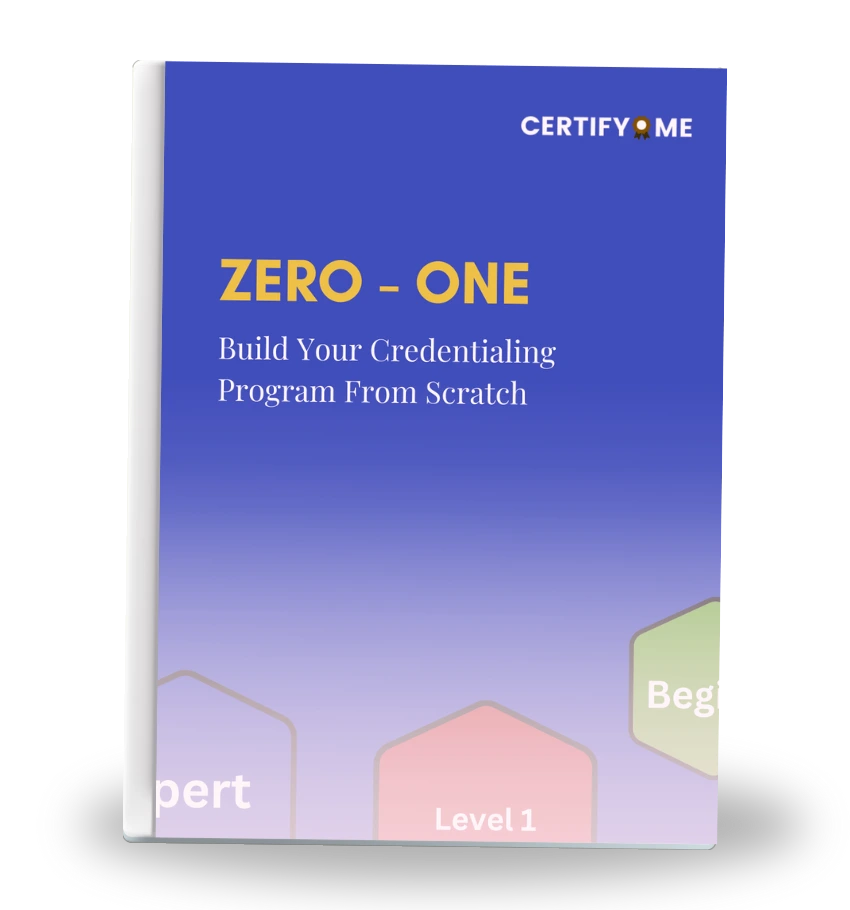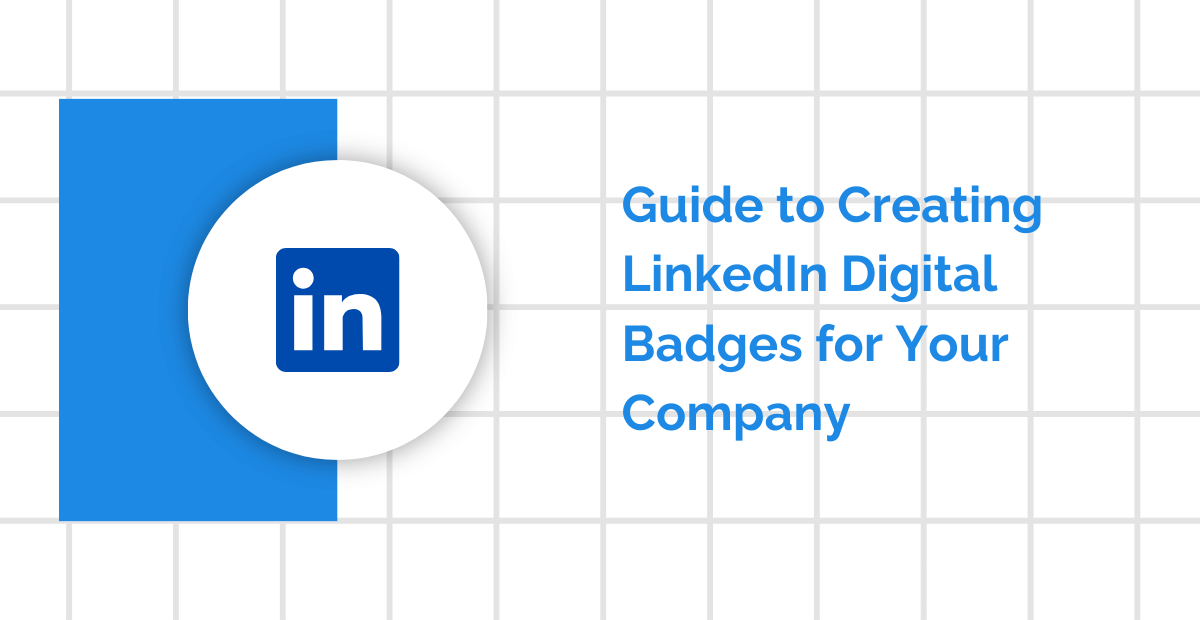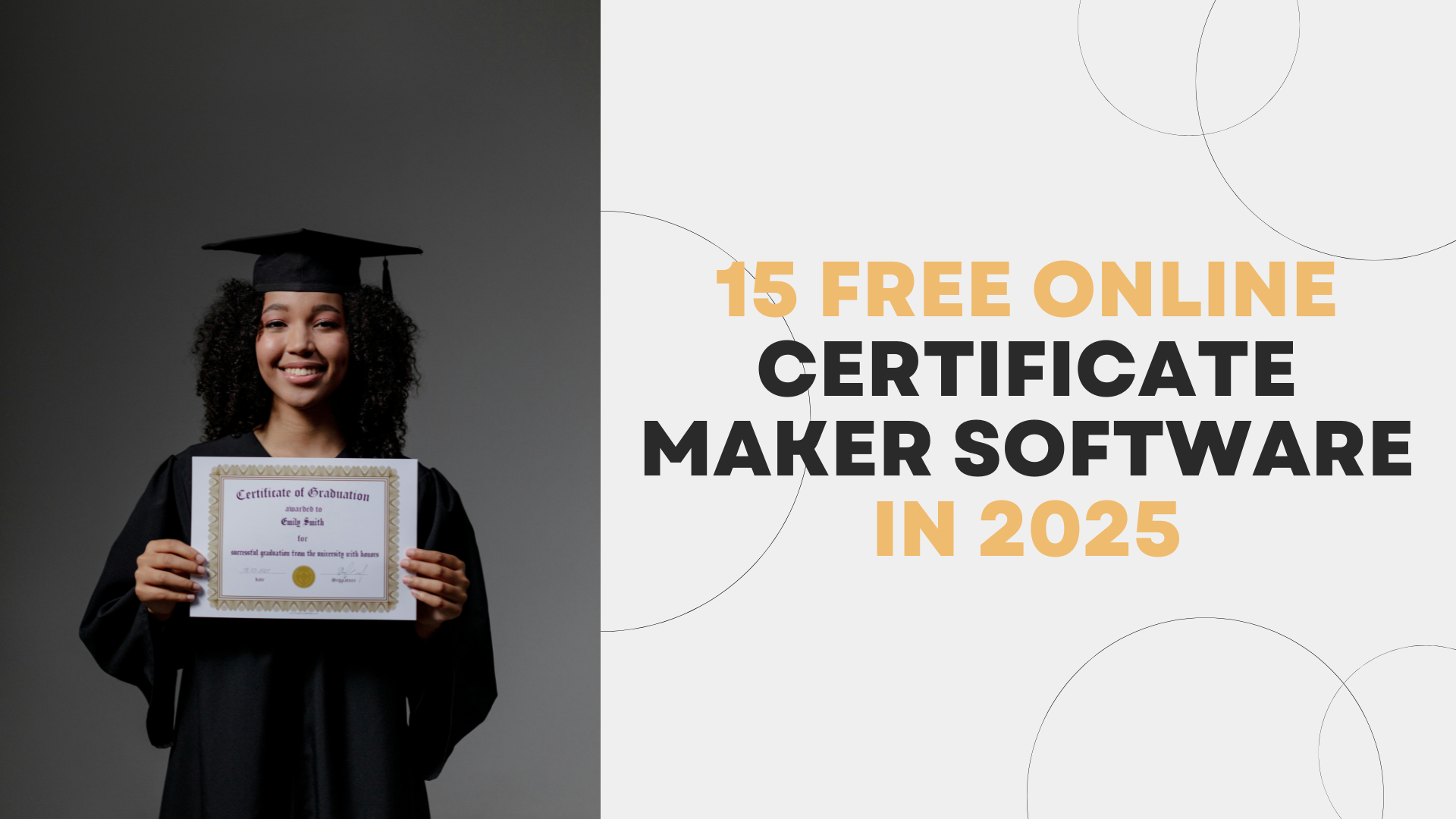Have you ever watched someone get hired not because they were the most qualified, but because they had a fancy degree, a familiar last name, or just “looked right for the part”? Unfortunately, bias in hiring is nothing new. It sneaks into decisions in subtle ways, even when people think they’re being fair. A resume with a certain zip code, a gap year that needs explaining, or an unfamiliar university name can all affect how a candidate is seen.
But what if hiring could be more objective? What if employers focused only on your skills, your achievements, and your actual work — not your background, your appearance, or who you know?
That’s where verified credentials come in. These are not just digital certificates or badges. They’re verifiable proof of your accomplishments, skills, and education — issued and confirmed by a trusted source. Whether you’re a student applying for internships or a university staff member guiding learners into the job market, understanding this tool could reshape how we approach hiring.
This blog is like a conversation with a good friend. We’ll break down the idea of verified credentials, explore the problem of bias in hiring, and look at how we can use technology to make the workforce more fair. No jargon. No hype. Just clear, useful info.
What Do We Mean by “Bias” in the Workplace?
Bias, simply put, is when someone makes a decision based on personal judgments or assumptions, instead of facts. And in hiring, bias shows up in ways that are often invisible until you really look.
Let’s break this down. There’s conscious bias — where someone clearly prefers one kind of person over another. That’s the most obvious kind. But unconscious bias is trickier. It happens quietly in the background. It’s when someone assumes that a candidate with an Ivy League degree must be smarter, or that a woman might not want a leadership role because of “family commitments.”
Bias isn’t always about malice. Sometimes it’s just a habit or conditioning. But the result is the same: talented people get overlooked. Qualified candidates miss out. And workplaces end up less diverse and less dynamic.
Think of these scenarios:
-
A hiring manager dismisses a candidate who took a non-traditional education path.
-
A resume with a non-Western name doesn’t get a callback.
-
A woman gets passed over for a field job because she’s “too soft-spoken.” - a small example of why we must support women to stay and grow at work through intentional hiring and development strategies.
Now multiply that across hundreds or thousands of hiring decisions. You see how structural inequality gets reinforced.
Here’s where universities and institutions can play a powerful role. By focusing on skills, experiences, and proof of learning — and reducing reliance on pedigree — they can prepare students to be evaluated more fairly in the real world.
And verified credentials offer a way to start.
Enter Verified Credentials: A Quick Primer
Imagine you’re applying for a job. You list out your skills: data analysis, team leadership, project management. You even mention the online course you took last summer. But how does your future employer know that any of that is true?
That’s the whole point of verified credentials. They provide proof. Not just claims. These are digital records issued by institutions, organizations, or training platforms that vouch for your skills or accomplishments. And they’re not PDFs you can edit. They’re secured, shareable, and easy to verify.
For example:
-
A digital badge from your university showing you completed a leadership workshop.
-
A verified certificate from Coursera or edX for finishing a Python programming course.
-
A credential showing your CPR training issued by the Red Cross.
They are issued using blockchain or similar secure technologies to make sure they can’t be faked or altered. The best part? They can be shared with just a link, or even embedded on your LinkedIn profile.
Why does this matter?
Because traditional resumes are full of fluff. And hiring teams are overwhelmed. They don’t have the time to verify every claim. W3C verifiable credentials do that work for them. They build trust. They reduce guesswork.
Plus, for students who may not have fancy internships or elite schools on their resumes, these credentials offer a way to stand out. They prove learning, growth, and readiness. They put the focus back on what you know and what you can do, instead of what your background says about you.
In short? Verified credentials are like little trust signals. And when trust is equal for everyone, bias has a lot less room to sneak in.
How Verified Credentials Can Reduce Bias
So how exactly do verified credentials help in reducing bias? Let’s unpack this in a few simple, concrete ways:
a. Skills Over Skin-Deep Judgments
Instead of judging a candidate based on name, school, or network, employers see verified proof of skills. For instance, a badge in conflict resolution says more about a student’s ability to manage a team than their major might. The focus shifts from surface-level markers to real-world capabilities.
b. Everyone Presents the Same Kind of Proof
When candidates share verified credentials, it levels the playing field. It’s no longer about who had access to better resume-writing workshops or insider referrals. Everyone uses the same transparent system to show their qualifications.
c. Resumes Are No Longer the Sole Judge
Resumes are subjective and often misleading. Verified credentials reduce reliance on them. Employers can sort through applications based on specific skills or certifications, rather than vague job descriptions or buzzwords.
d. Blind Hiring Becomes Easier
Blind recruitment is when you remove names, genders, or photos from applications to prevent bias. Verified credentials support this by giving recruiters skill-based data to work with. A recruiter doesn’t need to know your name to trust that you’ve earned a badge in public speaking.
e. Opportunities for Everyone, Not Just the Privileged
People from non-traditional backgrounds often miss out due to bias. But if you can prove your skills with verified credentials, you’re on equal footing. You don’t need a referral. You don’t need to know someone inside the company. You just need to show what you can do.
This approach also helps employers. Diverse teams perform better. Less biased hiring leads to stronger teams, greater innovation, and better outcomes. It’s not just fair. It’s smart.

Real-World Impact: What This Looks Like in Action
This all sounds great in theory. But what does it look like in real life?
Let’s start with students. Imagine Maya, a psychology major who also completed a conflict-resolution workshop offered by her university. She receives a verified credential for that course and shares it on LinkedIn. A recruiter from a nonprofit sees it and reaches out. That badge helped Maya stand out — not her GPA, not her university ranking, but her proven skills.
Now let’s talk about an employer. A small startup wants to reduce hiring bias. They start using a digital credential platform. Instead of reviewing resumes first, they create a filter: candidates with a project management badge and a customer service credential get priority. This removes names, photos, and alma maters from the first round. Result? More diverse hires and better fit for roles.
Want to see more real HR examples using digital credentials? Here’s how companies are already applying this approach to hire more fairly and effectively.
Even universities benefit. One college in Ohio began issuing digital badges for extracurricular programs like student governance and peer mentoring. These didn’t count for course credit, but they mattered in the real world. Employers started recognizing them. Students felt more confident. And the university became known for preparing students beyond academics.
And here’s a personal anecdote: A friend of mine, Josh, didn’t attend a top school. He didn’t have connections. But he collected verified credentials in graphic design, web development, and client communication from trusted platforms. He built a portfolio, attached the credentials, and applied for freelance work. Within six months, he was making more than many full-time designers. Bias couldn’t touch his proof.
Stories like these show that verified credentials aren’t just tech buzz. They’re changing how people get noticed, get hired, and get ahead.
Why This Matters to Universities Too
Universities do more than deliver degrees. They shape futures. But the world is changing. Employers aren’t just looking for a diploma anymore. They want evidence of skills, experiences, and practical know-how.
Verified credentials let universities show this value. They go beyond grades and transcripts. A certificate in intercultural teamwork, a badge in crisis response, a credential in academic writing — these all highlight what students can actually do.
For students:
-
It helps them tell their story. Not every learning experience fits neatly on a transcript.
-
It adds professional weight to campus activities. Running a club or organizing an event becomes resume-worthy.
-
It gives them portable proof. They can share it online, in portfolios, or on job applications.
For university staff:
-
It’s a way to modernize programs without overhauling the curriculum.
-
It provides data and feedback on which skills are in demand.
-
It strengthens student outcomes, making graduates more employable.
Verified credentials are also making waves beyond higher ed—check out credentialing use cases in event and meetings industries to see how they scale across sectors.
And for institutions overall:
-
It shows commitment to equity. If your school supports verified credentials, you’re helping reduce hiring bias.
-
It boosts reputation. Employers take notice when your graduates come with credentials they can trust.
Universities have the chance to be leaders in this shift. By issuing credentials that reflect real-world readiness, they empower students in ways that degrees alone sometimes can’t.
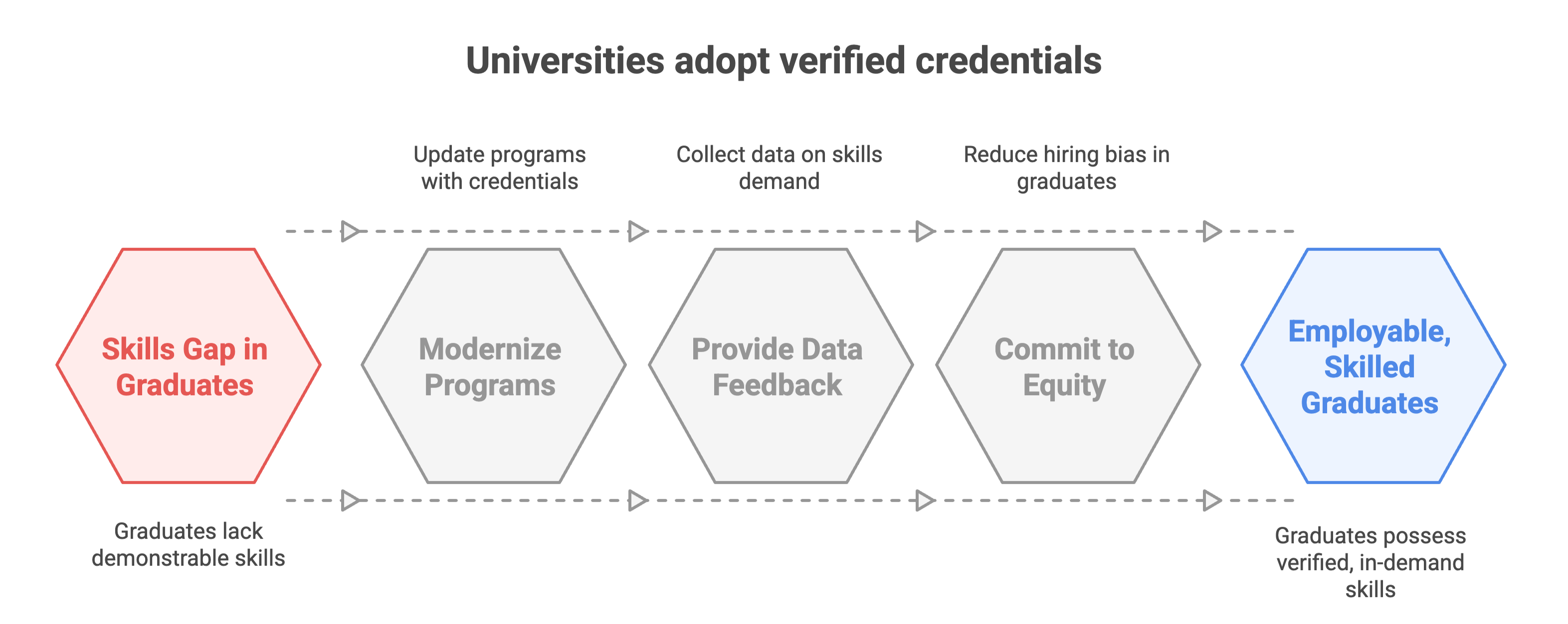
What You Can Do Next
Let’s get practical. Whether you’re a student, a staff member, or someone hiring — here’s how you can start using verified credentials to reduce bias and support fairness.
For Students:
-
Ask your school if they issue digital credentials for workshops, training, or extracurricular programs.
-
Take part in learning experiences outside the classroom and earn credentials for them.
-
Add your credentials to your LinkedIn, resume, and online portfolio. Let employers see your skills clearly.
For University Staff:
-
Start small. Try issuing credentials for leadership roles, career workshops, or language programs.
-
Partner with platforms like CertifyMe to simplify credential management.
-
Educate students on how to use and share credentials effectively.
For Employers:
-
Pilot blind hiring with credential-based shortlisting.
-
Ask for proof of skills, not just job titles.
-
Use credential platforms to verify applicant qualifications easily.
Fair hiring is not a dream. It’s a series of steps. Verified credentials make those steps easier to take.
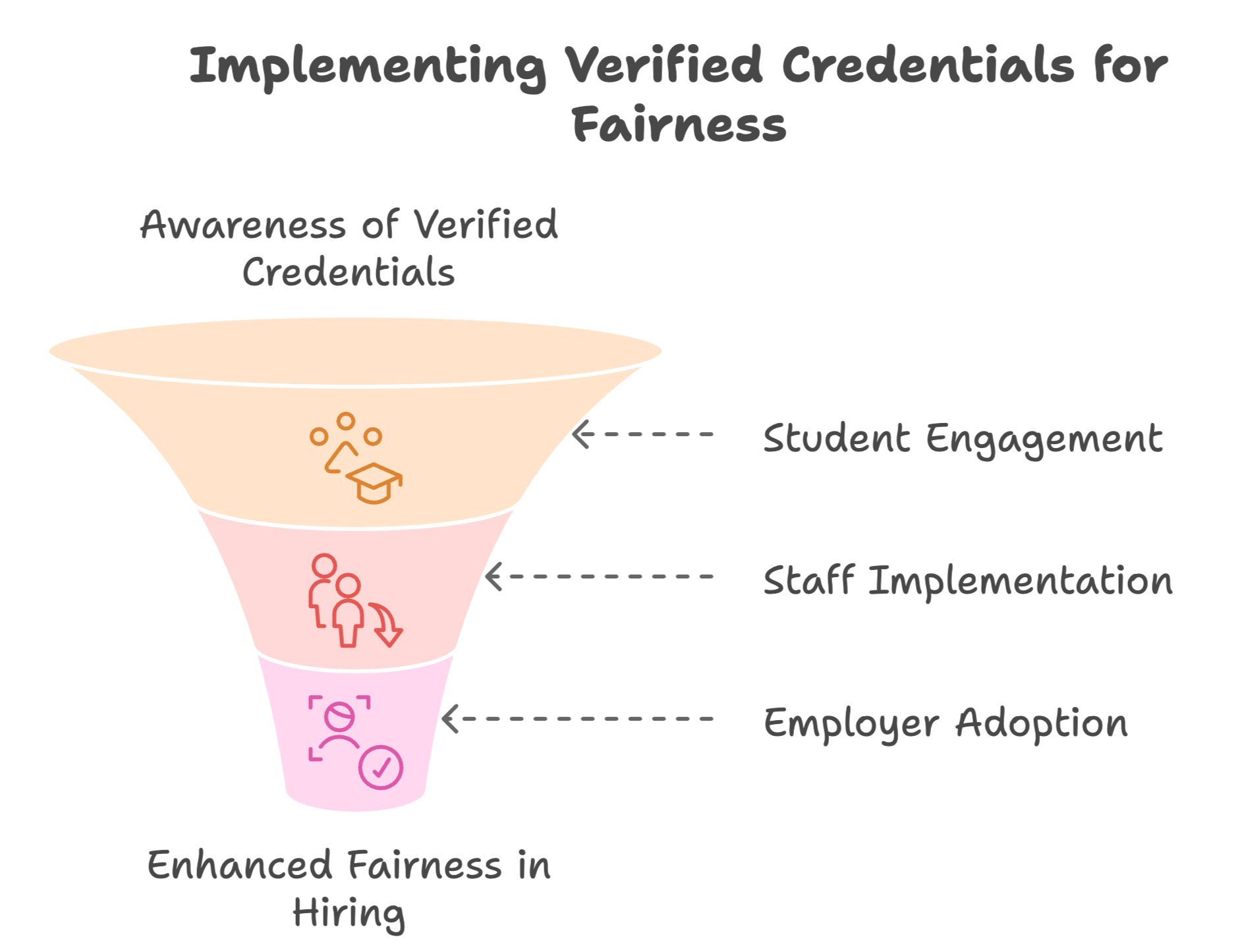
Final Thoughts: Fairness Isn’t Just an Ideal — It’s a Process
Bias won’t disappear overnight. But we can chip away at it. One badge. One credential. One fair decision at a time.
When you focus on what people know instead of who they are, you open doors that bias tries to keep shut. Verified credentials don’t just help individuals get hired. They help systems grow fairer.
If you’re a student, start collecting proof of your skills. If you’re an educator, start issuing credentials. If you’re an employer, start trusting verified accomplishments over assumptions.
Because a bias-free workforce isn’t just better for people. It’s better for performance, trust, and the future.
Bias won’t disappear overnight, but we don’t have to wait for perfect conditions to start moving in the right direction. Each verified credential is like a building block toward a hiring process that sees people for their skills—not their background. It’s not about ignoring identity; it’s about valuing ability. That shift starts when we choose evidence over assumption.
Whether you’re a student trying to stand out, a university staff member hoping to better support learners, or someone involved in hiring—you can help make hiring more fair. And it doesn’t take much. Sharing your verified skills, issuing portable credentials, or reviewing applications with a new lens—it all adds up. Little steps can change big systems.
If you’re curious where to begin, check out CertifyMe. It’s a platform that helps institutions create and issue digital credentials that are easy to verify, hard to fake, and simple to share. Students get recognition they can carry anywhere. Staff get tools that simplify the credentialing process.
Interested? Book a quick demo to see how it could fit into your work or campus.

 Author :
Author : 

